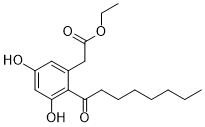Cytosporone B
This product is for research use only, not for human use. We do not sell to patients.

For small sizes, please check our retail website as below: www.invivochem.com
| Size | Price | Stock |
|---|---|---|
| 250mg | $1080 | Check With Us |
| 500mg | $1750 | Check With Us |
| 1g | $2625 | Check With Us |
Cat #: V3098 CAS #: 321661-62-5 Purity ≥ 98%
Description: Cytosporone B (Dothiorelone G; Csn-B) is a naturally occurring octaketide isolated from an endophytic fungus Cytospora sp, acting as an agonist for the nuclear orphan receptor Nur77 (EC50 = 0.278 nM) with antitumor activity.
Top Publications Citing Invivochem Products
Publications Citing InvivoChem Products
Product Promise

- Physicochemical and Storage Information
- Protocol
- Related Biological Data
- Stock Solution Preparation
- Quality Control Documentation
| Molecular Weight (MW) | 322.4 |
|---|---|
| Molecular Formula | C18H26O5 |
| CAS No. | 321661-62-5 |
| Storage | -20℃ for 3 years in powder formr |
| -80℃ for 2 years in solvent | |
| Solubility In Vitro | DMSO: 10 mMr |
| Water: N/Ar | |
| Ethanol: N/A | |
| SMILES Code | O=C(OCC)CC1=CC(O)=CC(O)=C1C(CCCCCCC)=O |
| Synonyms | Cytosporone B, Csn-B |
| Protocol | In Vitro | Cytosporone B targets the ligand binding domain of Nur77, which selectively stimulates the transactivational activity of Nur77. Cytosporone B induces luciferase activity in cells that are cotransfected with GAL4- Nur77 or GAL4-LBD. The EC50 of cytosporone B for Nur77 is 0.278 nM. Cytosporone B displays robust pro-apoptotic activity in gastric cancer cells BGC-823. 63.5% of the cells are apoptotic when treated with cytosporone B for 48 h. Cytosporone B shows selective effect on cancerous cells. Cytosporone B inhibits proliferation of human gastric cancer BGC-823 cells and human colon cancer SW620 cells by 470%, but it has a modest effect on human lung cancer H1299 cells and human hepatoma HepG2 cells. |
|---|---|---|
| In Vivo | In the hepatocytes of wild-type mice, the transcriptional activity of the reporter is induced five-fold with cytosporone B treatment. In wild-type mice, cytosporone B treatment significantly increases glucose levels from 3.2 to 11.4 mM within the first 30 min, and thereafter blood glucose gradually decreased before reaching the initial level after 300 min. |
These protocols are for reference only. InvivoChem does not
independently validate these methods.
| Solvent volume to be added | Mass (the weight of a compound) | |||
|---|---|---|---|---|
| Mother liquor concentration | 1mg | 5mg | 10mg | 20mg |
| 1mM | 3.1017 mL | 15.5087 mL | 31.0174 mL | 62.0347 mL |
| 5mM | 0.6203 mL | 3.1017 mL | 6.2035 mL | 12.4069 mL |
| 10mM | 0.3102 mL | 1.5509 mL | 3.1017 mL | 6.2035 mL |
| 20mM | 0.1551 mL | 0.7754 mL | 1.5509 mL | 3.1017 mL |
The molarity calculator equation
Mass(g) = Concentration(mol/L) × Volume(L) × Molecular Weight(g/mol)
Mass
=
Concentration
×
Volume
×
Molecular Weight*
The dilution calculator equation
Concentration(start)
×
Volume(start)
=
Concentration(final)
×
Volume(final)
This equation is commonly abbreviated as: C1 V1 = C2 V2
Concentration(start)
C1
×
Volume(start)
V1
=
Concentration(final)
C2
×
Volume(final)
V2
Step One: Enter information below
Dosage mg/kg
Average weight of animals g
Dosing volume per animal µL
Number of animals
Step Two: Enter the in vivo formulation
%DMSO
+
%
+
%Tween 80
+
%ddH2O
Calculation Results:
Working concentration:
mg/ml;
Method for preparing DMSO master liquid:
mg
drug pre-dissolved in
µL
DMSO(Master liquid concentration
mg/mL)
,Please contact us first if the concentration exceeds the DMSO solubility of the batch of drug.
Method for preparing in vivo formulation:
Take
µL
DMSO master liquid, next add
µL
PEG300, mix and clarify, next add
µL
Tween 80,mix and clarify, next add
µL
ddH2O,mix and clarify.
Note:
- (1) Please be sure that the solution is clear before the addition of next solvent. Dissolution methods like vortex, ultrasound or warming and heat may be used to aid dissolving.
- (2) Be sure to add the solvent(s) in order.




































